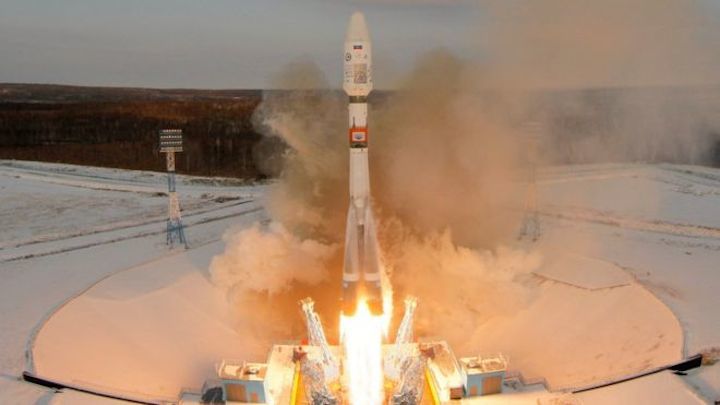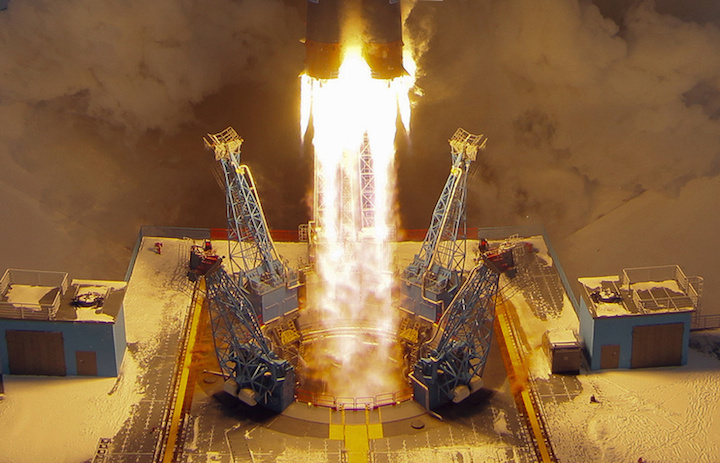EDITOR’S NOTE: The Soyuz rocket lifted off on time at 0541 GMT (12:41 a.m. EST) Tuesday, beginning a four-hour flight sequence to deploy 19 satellites into three different orbits. Check back here for a full report after the launch sequence is completed.

A Soyuz rocket is scheduled to lift off Tuesday from a launch pad in Russia’s Far East with a new Russian weather satellite and 18 secondary payloads from companies and institutions in the United States, Canada, Japan, Norway, Sweden and Germany.
The liquid-fueled launcher is set for blastoff at 0541:46 GMT (12:41:46 a.m. EST) Tuesday from the Vostochny Cosmodrome, a facility in Russia’s Amur region near the Chinese border.
Liftoff is scheduled for 2:41 p.m. local time at Vostochny.
Tuesday’s flight will be the second launch from Vostochny, a multibillion-dollar spaceport built to help Russia shift more launches to its own territory from the Baikonur Cosmodrome in Kazakhstan. A Soyuz rocket made the first launch from the Siberian spaceport in April 2016.
Russia’s Meteor M2-1 weather satellite is the Soyuz rocket’s main passenger, beginning a five-year mission collecting imagery and data for Roshydromet, the Russian government’s weather agency. Launch services for the 17 satellites from international customers were booked through Glavkosmos, a Russian commercial launch broker.
The Soyuz-2.1b rocket will head north from Vostochny, dropping its four kerosene-fueled boosters, nose shroud and core stage to fall in the Siberian forest. A third stage powered by an RD-0124 engine and a Fregat upper stage will deliver the satellites to a preliminary parking orbit about 12 minutes into the flight.
The Fregat upper stage’s main engine will ignite seven times on Tuesday’s mission, first to place the Meteor M2-1 weather satellite into its targeted orbit, then to maneuver to different altitudes for deployment of 18 more spacecraft.
The seventh and final Fregat main engine burn will steer the upper stage back into Earth’s atmosphere for a destructive re-entry in the Pacific Ocean southwest of Mexico.
The 6,062-pound (2,750-kilogram) Meteor M2-1 weather observatory awaiting launch Tuesday carries four meteorological instruments: two multi-channel scanners and cameras to obtain infrared and visible images of clouds and ice cover, a microwave radiometer to measure temperature and humidity in the atmosphere, and an infrared spectrometer to monitor the ozone layer.
The Russian weather satellite also hosts a search-and-rescue radio transponder and a payload to relay data from remote weather stations and offshore buoys to Russian forecasters.
Meteor M2-1 is the first Russian weather satellite equipped to receive emergency distress beacons through the international Cospas-Sarsat network.
This video shows technicians readying the Meteor M2-1 weather satellite for launch, including the removal of instrument covers and other ground equipment before encapsulation inside the Soyuz rocket’s payload fairing. Video credit: Roscosmos
Built by VNIIEM, a Moscow-based aerospace contractor, the Meteor M2-1 spacecraft is the third in a series of upgraded Meteor M weather satellites. Two Meteor M satellites launched in 2009 and 2014 are still functioning, according to VNIIEM.
Once operational in polar orbit around 513 miles (826 kilometers) above Earth, the Meteor M2-1 satellite will provide data inputs to help Russian meteorologists craft medium-range forecasts.
More than 70 Russian Meteor weather satellites have launched since 1964.
Separation of the Meteor M2-1 satellite from the Fregat upper stage is set for 0642 GMT (1:42 a.m. EST), shortly after the mission’s second Fregat main engine burn.
A third Fregat engine firing will move the perigee, or low point, of its orbit closer to Earth for deployment of the IDEA OSG 1 spacecraft shortly after 0800 GMT (3 a.m. EST) in an elliptical egg-shaped loop around the planet.
Manufactured and owned by the Japanese company Astroscale, the suitcase-sized IDEA OSG 1 satellite is covered with sensors to register impacts with tiny pieces of space junk smaller than a millimeter in diameter. The space debris detectors, developed by the Japan Aerospace Exploration Agency, will help tell scientists and engineers about the amount of space junk in low Earth orbit, focusing on satellite and rocket fragments too small to be tracked by ground-based radars.
The IDEA OSG 1 spacecraft’s two-year mission is sponsored by OSG Corp., a Japanese tool maker, and is the first of several satellites planned by Astroscale. A follow-on mission conceived in partnership with Britain’s Surrey Satellite Technology Ltd. could launch in 2019 to demonstrate a relatively low-cost method of removing small pieces of space debris from orbit.

Another 16-second firing of the Fregat main engine will circularize its orbit at an altitude of approximately 370 miles (600 kilometers) for the release of 16 more satellites.
The Baumanets 2 microsatellite built by students at Bauman Moscow State Technical University is set to separate from the Fregat upper stage at 0815 GMT (3:15 a.m. EST). The 190-pound (86-kilogram) spacecraft’s mission is primarily educational, but the satellite also carries an optical camera and a communications experiment.
A few minutes later, the Norwegian Space Center’s AISSat 3 satellite will deploy from the Fregat upper stage, kicking off a three-year mission to monitor ships and determine their position, speed and direction. The 14-pound (6.5-kilogram) spacecraft, built in Canada by the University of Toronto Institute for Aerospace Studies Space Flight Laboratory, is the latest in a series of Norwegian maritime tracking satellites.
A staggered deployment sequence for 14 CubeSats will come next. The exact order of the separation maneuvers has not been disclosed.
Two commercial Landmapper-BC CubeSats manufactured and owned by Astro Digital, formerly Aquila Space, are also on Tuesday’s Soyuz flight. They are the third and fourth Landmapper-BC satellites to launch, following two craft that flew on a Soyuz mission in July, and failed shortly after reaching space.
Astro Digital’s Landmapper-BC satellites are about the size of a shoebox and weigh around 22 pounds (10 kilograms), packing color and infrared cameras for wide-area imaging. The Silicon Valley-based company aims to field a commercial Earth-imaging fleet, initially with 10 CubeSat-class satellites.
San Francisco-based Spire Global has 10 Lemur-2 satellites on Tuesday’s Soyuz launch, ready to join the company’s commercial weather monitoring constellation.
Spire’s Lemur-2 craft carry GPS radio occultation antennas, using satellite navigation signals passed through Earth’s atmosphere to derive temperature and humidity profiles that can be fed into numerical forecast models.
Spire’s satellites — each weighing about 10 pounds (4.5 kilograms) — also track ships out of range of terrestrial receivers.
With Tuesday’s flight, the company will have launched a total of 67 Lemur-2 CubeSats, some of which have ended their missions.
Spire won a NOAA contract last year to supply pilot weather data to determine the information’s usefulness in forecasting.
Two European CubeSats will also be deployed.
The SEAM mission, led by Sweden’s KTH Royal Institute of Technology, will conduct measurements of magnetic and electric fields in the ionosphere, a layer in Earth’s upper atmosphere where auroras are generated. The SEAM spacecraft is also a pathfinder for the design of future small-scale European science missions.
Billed as the first German commercial CubeSat, the D-Star One spacecraft has four communications modules on-board, two of which will be used by the amateur radio community. Developed by German Orbital Systems in Berlin in cooperation with the Czech company iSky Technology, officials hope to build follow-on satellites to construct a low Earth orbit communications network.
Two more maneuvers by the Fregat upper stage will set up for separation of an experimental communications craft for Telesat, a leading Canadian-headquartered operator of large geostationary broadcast satellites.
Telesat ordered two demonstrator satellites in April 2016 to help engineers wring out technical hurdles before the company builds out a 117-satellite constellation to provide global broadband communications coverage from orbits less than 1,000 miles up, a goal officials say could be realized by 2021.
Telesat’s LEO Vantage 2 satellite is the first of the test craft to reach the launch pad. The roughly 154-pound (70-kilogram) prototype satellite was built by the University of Toronto Institute for Aerospace Studies Space Flight Laboratory, and Space Systems/Loral in Palo Alto, California, serves as prime contractor.

Telesat eyes the U.S. military and the aviation and maritime industries as prime markets for the Ka-band network. The satellites will also link under-served communities and far-flung outposts with high-speed Internet connectivity.
Another test satellite, named LEO Vantage 1, is set for launch on an Indian Polar Satellite Launch Vehicle in late December. It was provided by Surrey Satellite Technologies Ltd., a British subsidiary of Airbus Defense and Space.
Telesat will verify each satellite design’s capabilities and performance next year.
The LEO Vantage 2 spacecraft is expected to deploy from the Fregat upper stage into a 620-mile-high (1,000-kilometer) orbit at 0954 GMT (4:54 a.m. EST), followed by a final Fregat engine firing at 1043 GMT (5:43 a.m. EST) for a de-orbit burn.
Quelle: SN
+++
Update:
Meteor satellite launched from Vostochny may be in wrong orbit, Roscosmos says
A Soyuz-2.1b rocket blasted off from the Vostochny cosmodrome at 08:41 Moscow time with 19 space satellites on board
The satellite Meteor, launched from the Vostochny spaceport on Tuesday, is absent from the designated orbit and there is no contact with it, the Roscosmos corporation has said.
The first scheduled communication session has failed to establish contact with the satellite due to its absence from the designated orbit," the corporation’s spokesman said. "Analysis of the current situation is underway."
A Soyuz-2.1b rocket blasted off from the Vostochny cosmodrome at 08:41 Moscow time with 19 space satellites on board. The hydrometeorological satellite Meteor-M N. 2-1 was the main payload. The rocket also carried 18 smaller satellites.
Roscosmos said "the Soyuz 2.1b rocket put the booster Fregat and space satellite Meteor-M in the designated intermediate orbit."
+++
Russia loses contact with new weather satellite


Russia has lost contact with a weather satellite just hours after its launch from a new cosmodrome.
"Contact has not been established because it is not on its planned orbit," the space agency Roscosmos said. The Meteor-M satellite was carried on a Soyuz rocket.
The launch was at 14:41 (05:41 GMT), from Vostochny cosmodrome in Russia's far east. It is only the second launch from the base, which opened last year.
Smaller satellites were also on board.
Quelle: BBC
